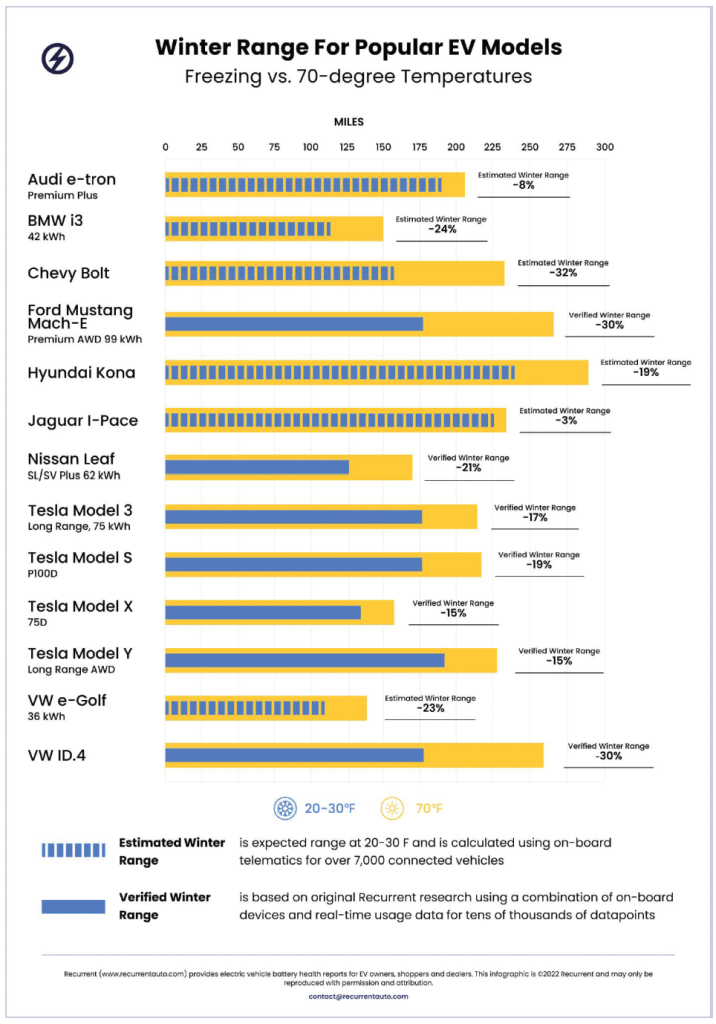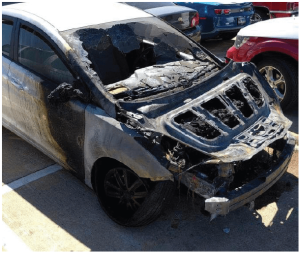COLD-HEARTED
Tesla models appear to fare better in cold weather when compared to other popular EVs, according to an updated range study by Recurrent Auto. Recurrent Auto obtained data from 7,000 vehicles across the United States and analyzed “tens of thousands” of data points from onboard devices providing data on energy usage. According to Recurrent’s data, the Model X and Model Y Long Range loses 15 percent of range when operating between -6°C and -1°C (20°F to 30°F); the Model 3 Long Range lost 17 percent and the Model S lost 19 percent of its range. For comparison, Ford’s Mach-E Premium AWD lost 30 percent—as did the Volkswagen iD.4. A 2020 study performed by the Norwegian Automobile Federation showed a 34 percent range reduction for the Tesla Model 3; Recurrent notes that this model did not have a heat pump, which now comes standard and has been shown to increase cold weather ranges. The Model Y uses a “more sophisticated heat pump system”, “help[ing] to regulate temperatures without drawing on the battery.” Teslas are also aided by localized cabin heating—from heated seats, steering wheels or other parts. Ultimately, the study concludes that though some range is lost when driving a Tesla in cold-weather conditions, “Tesla’s thermal management is still great at controlling cold weather range loss.”

Image from Recurrent Auto. Estimated winter ranges are based on onboard telematics and reflect the OEMs proprietary range calculations and software. Verified winter ranges are based on original Recurrent research using a combination of onboard devices and real-time usage data providing more than 35,000 data points.
MAKE SOME NEW NOISE
New sound requirements for hybrid and electric vehicles have been announced by Canada’s transport minister, citing increased collision risks towards cyclists, pedestrians and Canadians with disabilities among others. Minister Omar Alghabra announced mandatory minimum noise levels from hybrid and electric vehicles and equipping them with sound emitters that produce noise at low speeds. Under these new requirements, all hybrid and electric vehicles will be required to have sound emitters that produce noise at low speeds. While automakers can determine the actual noise sound made, the volume and pitch must clearly indicate if a vehicle is speeding up or slowing down. Most automakers have voluntarily added sound emitters to hybrid and electric vehicles prior to the announcement, which is currently in effect.
FLASH SALE
 Few things are bad enough to be called a burning wreck. Unfortunately for one man in Cambridge, Ontario, his 2015 Hyundai Sonata turned into one when his car burst into flames right as he pulled into the driveway. In an interview with the CBC, Mike Tennant described how a “large flame came up over the hood,” warning his wife that his car was on fire. According to the CBC, it was only 15 minutes since he picked up the car from a dealership after servicing on November 9, 2021. More than a year later, there remains no official cause or agreement over who or what was responsible. The CBC’s Go Public investigators contacted two experts with videos of the burning car and service records from the dealership. Eli Melnick, an electrical engineer, licensed mechanic and forensic investigator says that the intensity of the flames suggests it might have been fueled by an accelerant. The remains of the vehicle were sold by Allstate, who did not say whether an investigation was conducted before or after they sold the vehicle for salvage.
Few things are bad enough to be called a burning wreck. Unfortunately for one man in Cambridge, Ontario, his 2015 Hyundai Sonata turned into one when his car burst into flames right as he pulled into the driveway. In an interview with the CBC, Mike Tennant described how a “large flame came up over the hood,” warning his wife that his car was on fire. According to the CBC, it was only 15 minutes since he picked up the car from a dealership after servicing on November 9, 2021. More than a year later, there remains no official cause or agreement over who or what was responsible. The CBC’s Go Public investigators contacted two experts with videos of the burning car and service records from the dealership. Eli Melnick, an electrical engineer, licensed mechanic and forensic investigator says that the intensity of the flames suggests it might have been fueled by an accelerant. The remains of the vehicle were sold by Allstate, who did not say whether an investigation was conducted before or after they sold the vehicle for salvage.
Matt Carpenter, an instructor and expert in automotive mechanics at the Southern Alberta Institute of Technology made a similar assessment, highlighting that an accelerant accounts for the size and spread of the fire but not the root cause, with Melnick saying that 15 minutes was the approximate time for engines to reach operating temperature— hot enough to start a fire.
BUMP IN THE ROAD
News site CarBuzz recently unearthed a document indicating BMW’s exploration of a new suspension designed to harvest energy from potholes, speed bumps and other road defects. Whereas traditional suspension seeks to mitigate the bumps felt by a driver and their passengers, this new design aims to translate this jerky force into energy that feeds back into the vehicle. At the time of publishing, there are no details for when this system may rollout to customers or how much it might cost, though sources suspect the tech will be present on incoming electric models.





































